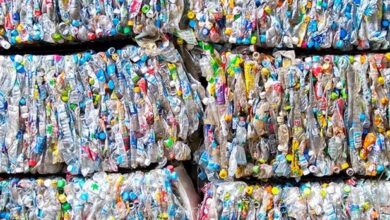
In an initiative that was one of the first of its kind in the country, a German-funded summer school program helped improve the playgrounds at two public primary schools — one in Ard al-Lewa and the other in Shubra — to help develop children’s responsibility toward their environment.
“Learn-Move-Play-Ground” was a summer school project organized from 22 September to 3 October by the German University in Cairo’s (GUC) architecture and urban design program and the Technical University in Berlin’s faculty of agriculture. It was financed by the German foreign affairs ministry through the German Academic Exchange Service, as part of grants provided by a transformation program launched last year to push the democratic process in Egypt and Tunisia.
The project involved children, teachers and parents in the creative process to redesign the courtyards and improve the quality of their schools’ outdoor spaces. To achieve this, a large team of university professors, Egyptian and German architects, urban planning and graphic design students, and other experts participated in the project.
Barbara Pampe and Vittoria Capresi, professors and two of the main organizers of the summer school project, describe how they got the idea.
“Children don’t learn only by reading and studying, as most people think,” says Pampe, an architecture design professor at the GUC. “More than 90 percent of what children learn in their daily lives comes from moving, playing and doing things to explore the world.”
Pampe says they visited 10 schools while preparing for the project, but prioritised schools that had enough space and where people were enthusiastic about helping. Eventually, they chose Al-Quds School in Ard al-Lewa and Kobbet al-Hawa School in Shubra.
Trees — which had previously been cruelly absent from both playgrounds — were planted to provide shade, while banks were installed below the trees and around the playground for children to rest on. Colorful wooden structures and concrete tubes were installed to slide and climb on.
Capresi, architecture history professor at GUC, says implementing such a project isn’t as easy as it looks. They began applying for permissions and grants a year and a half ago, and faced many obstacles.
“We spent more than seven hours in the Education Ministry to get permission to start working in the schools,” she says.
But she adds that they had very cooperative and supportive neighbors, who often gave them fresh food and lights when they worked at night.
A GUC architecture student who helped implement the project, Ibrahim Hany, describes the main stages the project went through. First, a group of 35 students went to the selected schools to see the environment in which the children studied.
They then held a workshop in which they found a new, creative way of communicating with the children: They gave them pictures and asked them to create collages to describe the place and atmosphere they dreamed of playing in.
Then they took some measurements for the available space and returned to GUC, where the project’s second step began. The university hosted experts who gave lectures about the application techniques and the aspects that needed to be considered while designing the playgrounds.
During the design stage, they began turning the children’s ideas into 3-D paper models, adding more details and materials, bearing in mind each school’s available space. But moving to the schools to implement the project was the hardest step.
The team adopted different strategies for each school depending on the number of students. At Al-Quds School, all the materials used were concrete and fixed to the foundations, so no one could break or move them. At Kobbet al-Hawa School, the team used wooden materials and bricks.
“Although the main objective of this project is developing the schools themselves, it had a great effect on the mentality of the children, who were taught how to be positive and take care of their environment,” Hany says. “It’s extremely inspiring to tap into the creativity of these children who live in slum areas.”
He adds that the experience helped him develop personally, and allowed him to work with diverse students from different backgrounds, including Germany and many universities across Egypt.
Impressed by the playground project, Cairo Climate Talks, a large joint project initiated by the German Embassy in Cairo, providing a platform to exchange experiences in the fields of energy and environment, donated the trees for the two schools. Solveig Rietschel, general coordinator of the project, says she is willing and ready to support any environment projects in the future.
Reneh Beshay Melek, administrator of Kobbet al-Hawa School, is grateful to the team who worked on the project. She says teachers welcomed the idea because they know their students are poor and can’t afford to go to clubs or practice sports. The schoolyard is often their only way to play outdoors.
The school intends to use the new playground as an incentive for students to study harder and listen to their teachers. It also plans to hold a “curricula theater” to present the topics the students study in their textbooks in the form of plays, simplifying the lessons for them.
“Now we have a new vision for our schools,” Melek says. “We intend to teach children how to pay more attention to the environment and how to take care of the trees. We will teach children how to recycle their home waste and broken toys, and organize exhibitions for them.”
The program, however, has also attracted some criticism.
Omar Nagati, a practicing architect and urban planner, says he thinks such projects should focus on exposing informal areas that lack basic services and infrastructure, rather than adding architectural value to schools.
Nagati says that, while the project was successful and the team exerted a lot of effort to achieve their goals, using limited resources and time, experts worked from their perspective and not necessarily from that of the local community.
Furthermore, the presence of an international group has generated conflicted responses, raising the expectations of some administrators and teachers at the schools and then leaving them quite disappointed by the results, he says. On the other hand, bringing media attention to otherwise marginalized neighborhoods could be used as leverage to negotiate with authorities and improve conditions.
Nagati was also critical about what he says is an increasing number of foreign workshops in the country after the 25 January revolution.
“In my opinion, the most dangerous thing is converting informal areas and local communities in Egypt into case studies used by the knowledge production centers in developed countries,” he says. “This kind of international division of labor is what the revolution meant to challenge. We need to engage development questions on our own terms.”
But Kai Boeckmann, deputy head of the German Embassy, says he is happy with the project, adding that he felt children’s and teachers’ sincere will to develop their environment when he visited the school. “I insisted on attending the opening ceremony of Al-Quds School and planting a tree with my bare hands to express the German Embassy’s support for such a project and its results,” he says.
Although he sees the project as a small step, Boeckmann says he thinks it will affect future generations on a wide scale, and hopes the media will be more active in covering environmental projects.
“The tree represents a symbol for all children’s dreams, as they can climb it or sit under its shadows,” he says.
This piece was originally published in Egypt Independent's weekly print edition.




